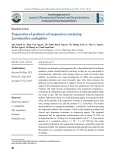
40
Research Article
Preparation of probiotic oil suspension containing
Lactobacillus acidophilus
Ngoc Khanh Lea, Khac Tiep Nguyena, Thi Thanh Duyen Nguyenb, Thi Phuong Linh Lea, Dieu Ly Nguyena,
Thi Hoa Nguyena, Thi Phuong Vua, Thanh Xuan Dama,*
aFaculty of Biotechnology, Hanoi University of Pharmacy, 13-15 Le Thanh Tong, Hanoi, Vietnam
bFaculty of Pharmaceutics and Pharmaceutical Technology, Hanoi University of Pharmacy, 13-15 Le Thanh Tong, Hanoi, Vietnam
Journal of Pharmaceutical Research and Drug Information, 2023, 14 (5): 40-46
A R T I C L E I N F O
Article history
Received 04 May 2023
Revised 17 Sept 2023
Accepted 25 Nov 2023
Keywords
Dispersion method
L. acidophilus
Oily suspension
Probiotic
Paediatric uses
A B S T R A C T
Probiotics are defined as microorganisms that, when administered in sufficient
quantities, confer a health benefit on the host. As they are very susceptible to
environmental conditions, solid dosage forms are used to increase their
stability. In pediatric use, liquid preparations of edible oily suspensions
containing probiotics are more favorable since they help overcome the
difficulty of oral administration in children. However, few research articles
related to the preparation process of these oily suspensions were reported in
Vietnam. Our study focuses on preparing an oily suspension containing L.
acidophilus at a laboratory scale, oriented for use in infants and children under
two years of age. The oily suspension was prepared using the dispersion
method. Different mixtures of oil and dispersing agents were studied for their
effect on the stability of the suspension in terms of sedimentation rate, drop
time, average particle size, and the amount of L. acidophilus. The results
showed that an oily suspension containing L. acidophilus could be made using
the dispersion method with a mixture of oils as the dispersion medium and
Aerosil and aluminum tristearate as dispersing agents. The prepared
suspension had an appropriate sedimentation rate of about 10–20%, an
average drop time of 1,0 drop/s, an average particle size of 3–3,5 µm, and an
amount of L. acidophilus above 3 x 108- 5 x 108CFU/ml. Our study
successfully prepared an oily suspension containing L. acidophilus using the
dispersion method. The prepared suspension had good physical stability, and
the number of L. acidophilus remained over 108CFU/ml during two months
of storage.
*Corresponding author: Thanh Xuan Dam; e-mail address: xuandt@hup.edu.vn
https://doi.org/10.59882/1859-364X/141
Journal homepage: jprdi.vn/JP
Journal of Pharmaceutical Research and Drug Information
An official journal of Hanoi University of Pharmacy






















